People often develop sequences of behaviour. They may follow certain patterns that result in positive or negative outcomes.
People can be helped to switch to positive sequences rather than negative sequences. This can help them to manage pressure, change a habit, replace an addiction, be more successful or whatever.
Imagine that a person has asked for your help in managing such a challenge. If this involves a medical issue, it is vital for them to get qualified help in this area. If the challenge falls within your area of expertise, however, you can provide tools they can use to shape their future.
Let’s explore how this works in practice. The following article is based on an actual person I worked with, though I have changed her name. You will, however, employ your own approach in your own way.
Clarifying the
negative sequence
Laura explained her experiences in the following way.
“My father died recently and since then I have had panic attacks. This is upsetting, because I am normally a competent person. My father’s death was unexpected. He and I were very close.
“Since his death I have taken care of the funeral, my mother, relatives, solicitors, everything. This is normally the case in the family and at work, but now I can’t take care of myself.
“Suddenly I get panic attacks in the street or at work. Certainly I know it will take time to come to terms with my father’s death and I expect to get mood swings.
“My doctor said there is nothing wrong medically. I don’t want to take anti-depressants, but I do need to find a way of dealing with the panic attacks.”
How to find a solution? Like many challenges, it revolved around a person wanting to feel more in control.
Laura recognised she needed to accept the grief cycle. She wanted to take control of her behaviour, however, rather than succumb to panic attacks. Trying to fight them did not work, so we took another approach.
Did she know when the attacks were going to happen? What were the warning signs? What preceded the attack? Laura described the sequence of what happened.
She felt tired through lack of sleep, often after spending hours counselling other people.
She was trying to concentrate on something, such as a task she must do at work.
She felt tingling in her hands that then crept up her body.
She felt detached and began to feel dizzy.
She had difficulty breathing and started to sweat.
She wanted to escape from the situation and, if possible, find a place to be quiet.
She managed to recover after 10 minutes and was able to resume what she had been doing before the attack.
If you wish, try tackling the exercise on this theme. Looking at your own life and work, can you think of a situation in which you get into a negative sequence? This could happen, for example, in some of the following scenarios.
You get depressed about something you hear and fall into a downward spiral.
You worry about things you can’t control and feel uneasy.
You get angry with a dirty fighter who pushes buttons that upset you and, as a result, you behave in a way that you regret afterwards.
Whatever the scenario, can you describe the negative sequence? This may start with physical signals and then move into more psychological symptoms. This exercise invites you to do the following things.
Describe a specific situation when you may get into a negative sequence.
Describe the specific things that happen at each stage of the negative sequence.
Describe the specific things that happen as a result of going through the negative sequence.
Clarifying the
positive sequence
Looking at this pattern, we explored where Laura could intervene to take more charge of the sequence. The question was: “How?”
Looking back at her life, when had she had managed similar challenges successfully? What did she do then? Laura gave the following explanation.
“Sometimes I play music. I go into my own world and, even if only for a few minutes, it works. I feel refreshed and ready to return to the world.
“Other times I go for a walk, move around or breathe slowly. I take notice of little things and appreciate life. This helps me to feel more alive and grateful.”
Different people have different rituals for embarking on positive sequences. This is certainly the case when people want to develop a healthy, rather than unhealthy, habit.
People who are addicts, for example, develop patterns that become a ritual. They begin thinking about a fix – be it tobacco, alcohol or whatever. They anticipate how it will feel, get physical sensations and perhaps approach a friend who also wants a fix.
They take the first step, such as reaching for the cigarette packet or whatever. They then follow their familiar road towards a specific outcome.
People who develop positive habits often do several things. They choose: a) To see the benefits; b) To commit themselves to achieving the goal; c) To take small steps that produce success. They then keep following these habits.
Peak performers also follow positive sequences. They know that following certain habits will increase their chances of achieving success. They follow these rituals when preparing to serve in tennis, go on stage or tackle other challenges.
Babette Rothschild is a therapist who specialises in safe trauma therapy. She says that people may need to add certain skills to their repertoires to deal with trauma, but it is also important to recognise their strengths.
She describes how people can build on their previous successful patterns. Writing in her book Trauma Essentials, Babette provides the following advice for therapists.
When the focus is on trauma, it is easy to forget the accompanying mechanisms that have helped people to survive and carry on, even when they have PTSD.
Resources of both the past and the present are important allies; they mediate the negative effects of trauma. Resources are partners that make survival and life after trauma possible.
Wise therapists will listen as carefully for coping mechanisms as they do for possible trauma.
If you wish, try tackling the exercise on this theme. Begin by recalling the specific situation in which you sometimes embark on a negative sequence.
Looking back, when have you been able to manage a similar challenge successfully? What did you do right then to follow a positive sequence?
Different people choose different ways to embark on positive sequences. You will, of course, have your own approach.
Bearing in mind the challenging situation that you may face, this exercise invites you to do the following things.
Describe a specific time when you followed a positive sequence to manage a similar challenge successfully.
Describe the specific things you did then to follow the positive sequence.
Describe the specific things that happened as a result of following the positive sequence.
Switching to a positive sequence
rather than a negative sequence
Laura looked at ways she could intervene to manage the panic attacks. This called for building on the right foundations.
She aimed to get more sleep and walk for an hour a day. Looking ahead, she planned to spend time with her encouragers, rather only counselling others. She would eat properly, which she had failed to do since her father’s death.
Laura then tackled one of the first warning signs – the tingling sensation in her hands. She could then switch the sequence by following her successful pattern – creating the space to play her favourite music.
Sometimes it might not be possible to use her iPod, so she developed other strategies for feeling calm. If she was in a meeting, for example, she would take time to breathe slowly and collect her thoughts.
If that did not work, she would find a reason to get up and walk around, such as asking if anybody wanted coffee. Seeing events in perspective, she would focus on the things she was grateful for in life.
Collecting her thoughts, Laura would clarify how she could support others in the meeting. She would prepare a script and clarify the three key things she wanted to say. After the meeting she would take time to reflect and re-centre.
Laura spent 30 minutes creating her action plan and rehearsing potential scenarios. She focused on the specific actions she could take to make the transition to a calmer state.
Two months later Laura reported that, whilst still experiencing mood swings, there were no panic attacks. She felt more in control and able to shape her future.
Don Greene is somebody who helps performing artists, athletes and others to perform at their best when under pressure. A deeply compassionate person, his work embodies the qualities of profound simplicity.
Many people will have heard about techniques such as centering and following positive scripting. Don provides many practical tools that people can use to put these ideas into action in real life situations.Here is a video that introduces his work with performing artists.
Different people use different ways to switch to positive sequences. You will have your own approach.
If you wish, try tackling the exercise on this theme. This invites you to do the following things.
Describe the specific situation when you may want to switch to following a positive sequence.
Describe the specific things you can do to switch to the positive sequence.
Describe the specific things that may happen as a result of switching to the positive sequence.


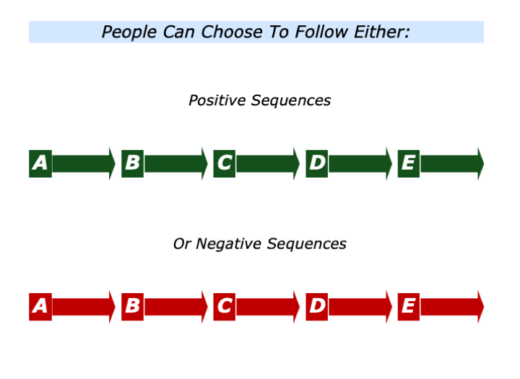
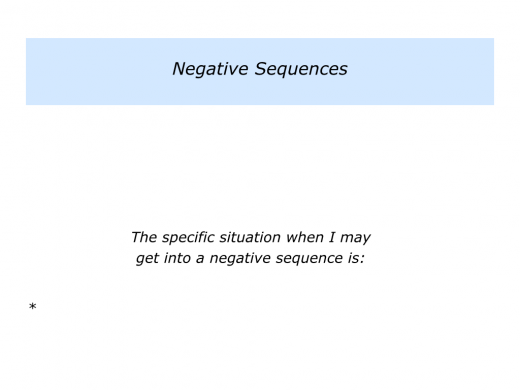
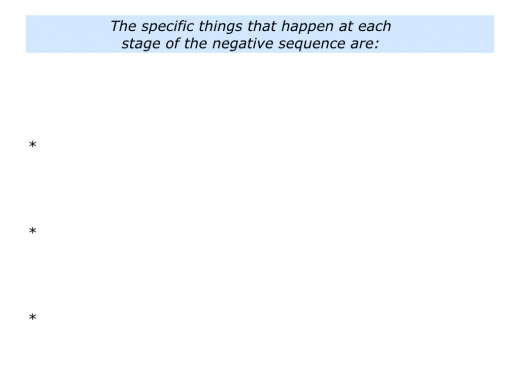
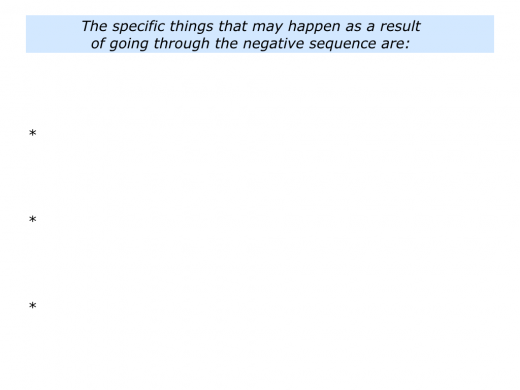
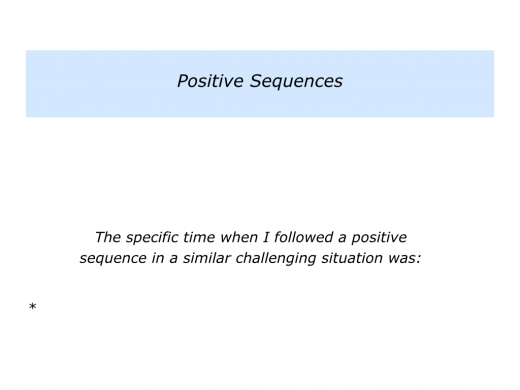
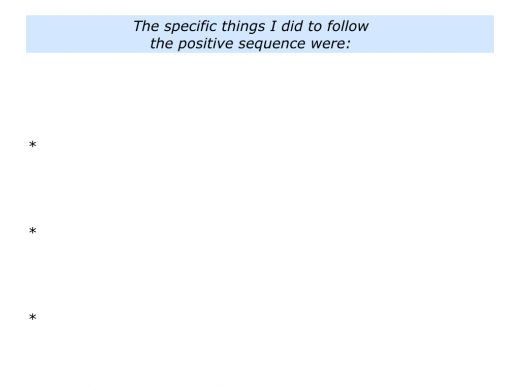
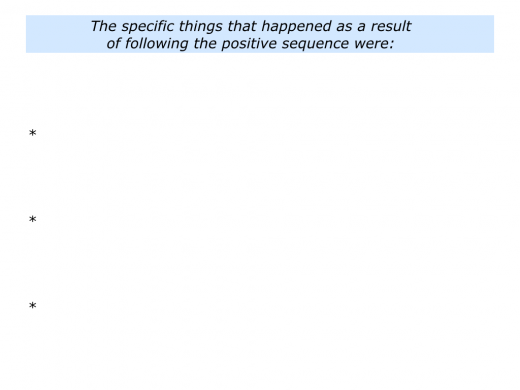
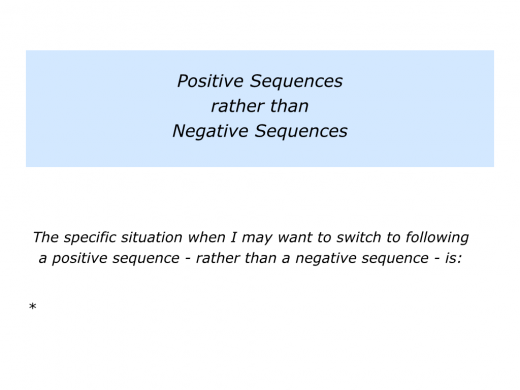
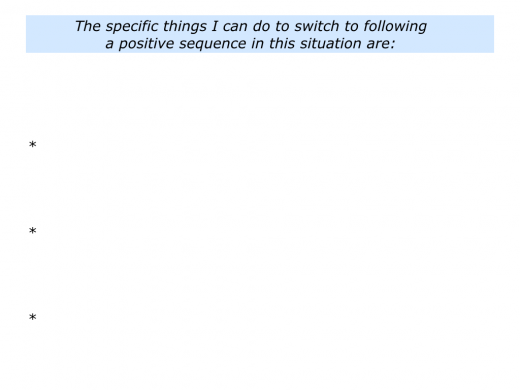
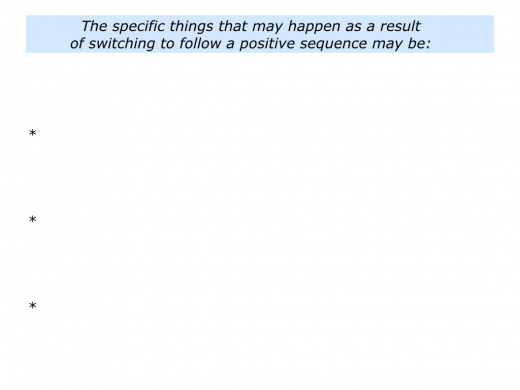




Leave a Reply